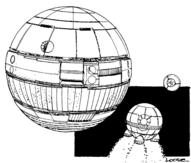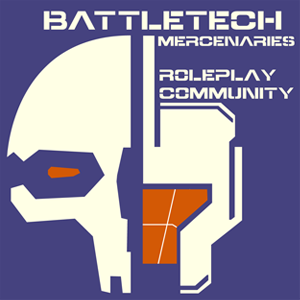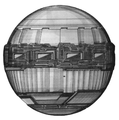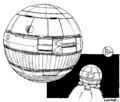Bastion (Space Station class)

| |
| Bastion | |
| Production information | |
| Manufacturer | Nicholas Spacecraft[1] |
| Type | Space Defense System |
| Tech Base | Inner Sphere[2] |
| Cost | |
| Introduced | 2584[3][4] |
| Technical specifications | |
| Mass | 150,000 |
| Length | 345m |
| Width | 345m |
| Thrust | |
| Fuel (tons) | 2000 |
| Fuel (days) | |
| LF battery | No |
| Armament |
|
| Armor | 20 (Capital scale, on each of six sides) |
| Structural Integrity | 1 |
| Docking Collars | 1 |
| Crew/Passengers | 400/25 |
| Grav Decks | 1x250m diameter |
| Escape Pods/Life Boats | 35/35 |
| Heat Sinks | 1000 Single Heat Sinks |
| BV (1.0) | 9,064 |
| BV (2.0) | |
Contents
Description[edit]
Designed in the early days of the Star League, the Bastion-class space station was the most common orbital fortress in the Space Defense Systems. It was also probably the first space station to be constructed from modular parts that could individually be docked to JumpShip hardpoints for jump transportation. The Bastion consists of two such modules massing 75,000 tons each, greatly simplifying the assembly process at their destination site.[1]
Though once common around many worlds, almost 500 years of continual warfare destroyed most of the stations that were deployed in border systems. By the 31st century, most of the Bastion stations were found in orbit around Successor State capital worlds or other important worlds located in the core of a state, with less than two dozen SLDF relics still existing.[4]
With the general loss of technology during the Succession Wars era, the Bastions and other stations like them were relegated to the sidelines. No attacker wanted to face a Bastion and no defender wanted to lose one. The Bastion instead changed its focus from combat to sentry duty: Capable of identifying attackers early,[5] and maintaining up to 48 aerospace fighters and small craft, the Bastion was a secure launch facility for defending jump points.
Weapons and Equipment[edit]
To fulfill its primary role, the Bastion mounts a variety of energy and projectile weapons. The LRM launchers engage targets at long range, supplemented by the PPCs and AC/5 mounted alongside them. As the enemy closes, the AC/10 and suite of laser weapons makes the area around the Bastion a bad place for an attacker to be. Astute observers will notice that these weapons are perfect for anti-aerospace Fighter operations, reflecting the reality of war during the Succession Wars. With no WarShips to defend against, any capital weapon systems were removed or replaced by more effective anti-fighter weaponry.
Cargo[edit]
Capable of carrying almost 126,000 tons of cargo, the Bastion dedicated much of this space to a pair of pressurized repair bays. Here, aerospace fighters, small craft, and even full-sized DropShips can undergo repairs.[6] These repair facilities proved to be useful to armies again and again.
The most daunting aspect of the Bastion is the access door to the main repair bay. A single large hatch opens the top third of the Bastion, allowing DropShip access to the main repair bay.[7] This bay can only handle DropShips smaller than 119 meters by 151 meters, but when the ship is in the bay and the hatch is closed, the DropShip isn't visible to any scanners. A hidden DropShip has been an unwelcome surprise to more than one attacker.
Variants[edit]
There are presumably many variants of the Bastion class as the design has been in service for nearly half a millennium. These variants are likely to swap the existing PPCs and lasers for extended range or pulse variants, or adding Artemis IV guidance systems to the LRM launchers. As the station already has so much armor, it is unlikely that any military would replace it with Ferro-Aluminum or Ferro-Carbide armor.
Named stations[edit]
(See List of named Bastion-class Space Stations)
Gallery[edit]
Original Bastion from DropShips and JumpShips: ComStar Intelligence Summary
Bastion from TRO:3057r
References[edit]
- ↑ 1.0 1.1 Interstellar Operations, p. 117
- ↑ Technical Readout: 3057, p. 204
- ↑ AeroTech 2 Record Sheets, p. 322
- ↑ 4.0 4.1 BattleSpace sourcebook, p. 60
- ↑ Technical Readout: 3057, p. 204, "A Bastion can detect ships in a 200,000km radius".
- ↑ Technical Readout: 3057, p. 204, "Pressurized repair bays can house ships up to 30,000 tons".
- ↑ DropShips and JumpShips: ComStar Intelligence Summary, p. 76




